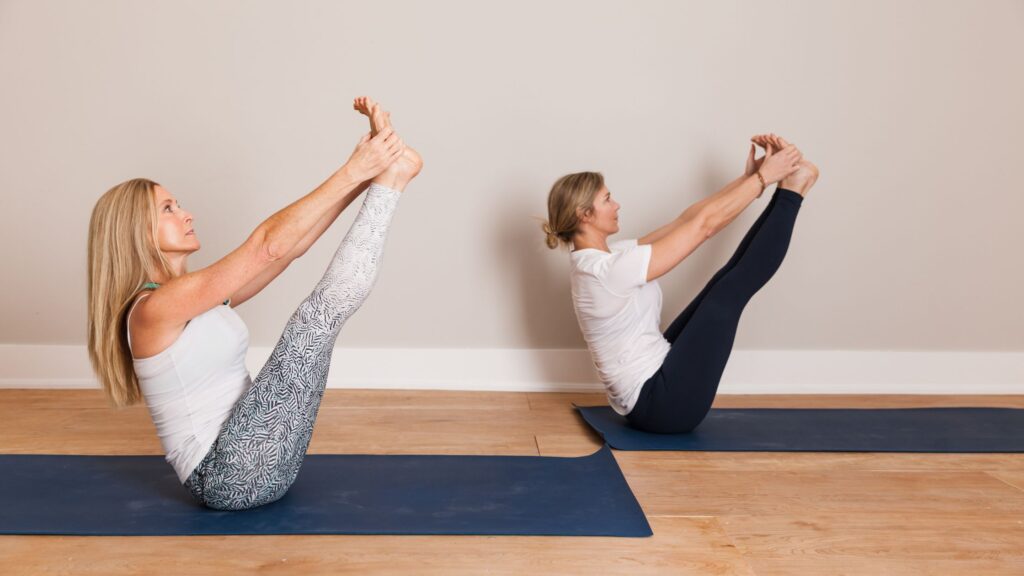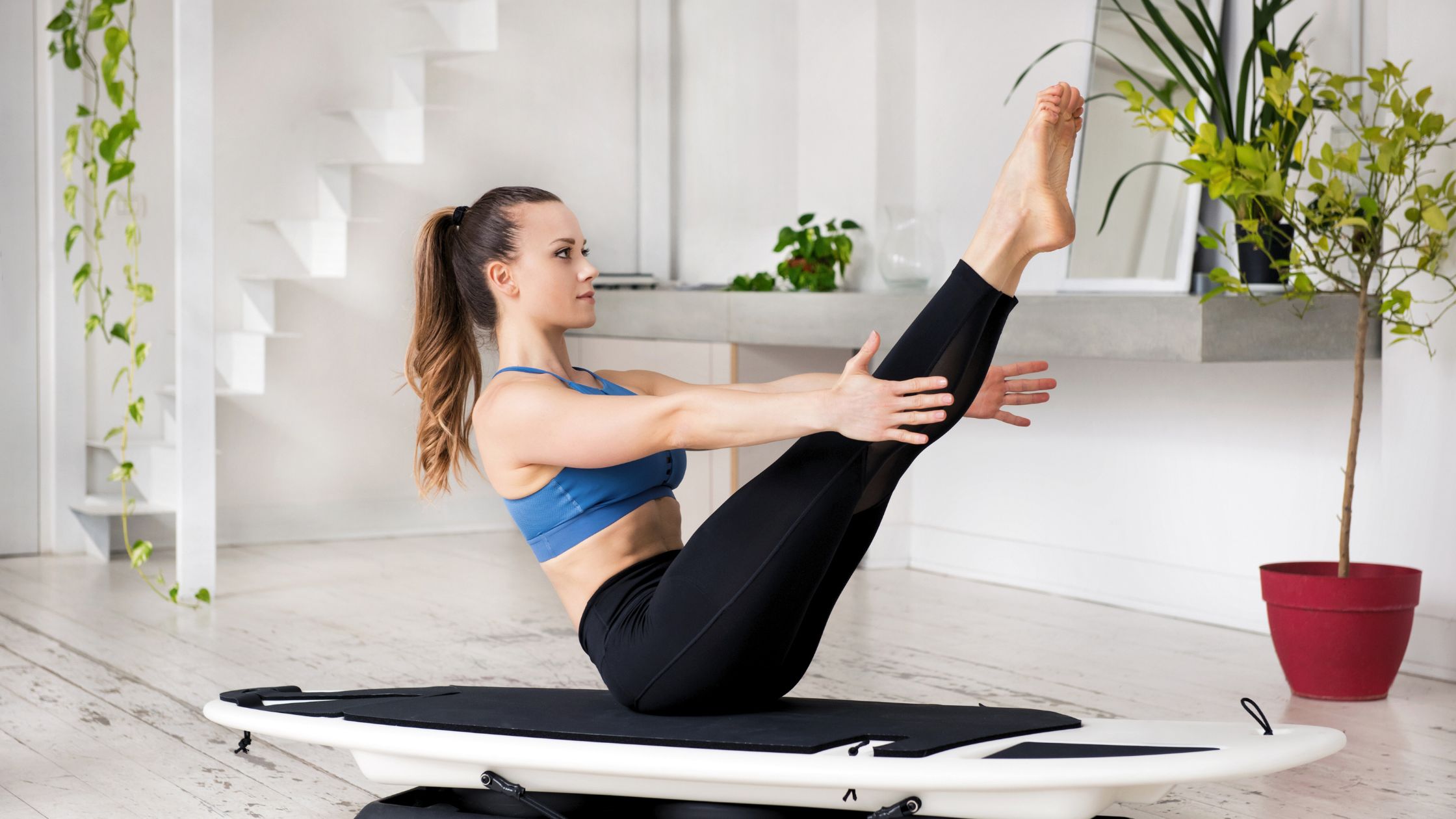Boat Pose Basics And Origins
Boat pose, or Paripurna Navasana (par-ee-POOR-nah nah-VAHS-anna) in Sanskrit, is a popular yoga posture that helps improve your core strength, balance, and posture. As a friendly introduction to this pose, let’s discuss some of the basics and its origins rooted in ancient yoga practice.
The term Paripurna Navasana is derived from two Sanskrit words: “paripurna” meaning complete, and “navasana” referring to a boat. Indeed, when practicing this pose, you resemble a boat, balancing on your sit bones with your legs and torso lifted. It’s a challenging posture, but with practice and patience, you’ll see improvements in your strength, balance, and body awareness.
One of the key benefits of boat pose is its emphasis on core strength. As you hold the position, you engage various muscles in your abdomen, lower back, and hip flexors. By consistently practicing this pose, you’ll not only develop a stronger core but also improve your overall stability and posture.
Additionally, boat pose enhances your balance, which is vital for many other yoga postures and day-to-day activities. When you practice this pose, you’ll notice that your weight shifts and that you’ll need to make subtle adjustments to remain balanced. Over time, this focus on maintaining equilibrium helps develop better body awareness and proprioception.
Now that you’ve learned about the basics and origins of boat pose, why not give it a try? Remember, be patient with yourself as you practice, and always listen to your body. As you continue to incorporate Paripurna Navasana into your yoga routine, you should see improvements in your core strength, balance, and posture, making your practice even more rewarding and enjoyable. Happy sailing!
Performing the Boat Pose

To start, sit in a comfortable seated position with your knees bent and feet flat on the floor. Place your hands behind your knees and lift your chest, engaging your back muscles as you inhale. Keep your spine elongated and avoid rounding it.
Now, lean back, placing the weight on the back of your sitting bones. Lift your feet off the floor, bringing your shins parallel to it while maintaining your bent knees in half boat pose. You should feel your torso slightly falling back, but remember not to let your spine round.
Once you’ve gained balance in the half boat pose, you can further challenge yourself by straightening your legs and arms. To do this, extend your legs out in front of you, and raise your arms parallel to the floor. Keep your chest open, and shoulders relaxed. Your body should create a “V” shape, with your hips as the lowest point.
Throughout the pose, focus on your breath and engage your core muscles to maintain stability. Do not hold your breath; instead, find a steady rhythm inhaling and exhaling, which will help you feel more grounded. Additionally, if you need extra support in this pose, you can place your hands on the floor beside your hips.
Remember, practicing the boat pose is not about how high you can lift your legs or how straight your arms are—it’s about finding balance and working on your core strength. Keep a friendly attitude in mind and listen to your body, adjusting the pose as necessary to suit your comfort and capabilities.
Important Elements
Using Your Body Parts
In Boat Pose, various body parts come into play. Engage your core muscles, including the abdomen and lower back, to stabilize your position, keeping a straight posture. Press your sitting bones and tailbone down to create a stable foundation. Place your palms beside your thighs or slightly behind the hips, helping to maintain balance.
Extend your legs and keep your thighs and hamstrings engaged. Flex your feet, keeping your shins parallel to the floor in Half Boat Pose, or fully extend your legs for Full Boat Pose. Open your chest, drawing your shoulder blades together to strengthen your back muscles, and ensure that your shoulders relax away from the ears.
Controlling Your Breath

Breathing plays a crucial role in the Boat Pose. During the posture, focus on deep inhales that expand your belly and ribcage. As you exhale, maintain the position without collapsing your chest or rounding your lower back. By synchronizing your breath with your movements, you’ll generate focus and easier execution of the pose.
Tips For Beginners
If you’re new to practicing Boat Pose, consider these tips for a safe and effective experience:
- Start in Dandasana (Staff Pose), seated with your legs extended in front of you, to establish a strong foundational position.
- Keep your knees bent, and initially practice Half Boat Pose with your shins parallel to the floor.
- Use a yoga block placed under your sit bones to support your pelvis and avoid straining your hip flexors or lower back.
- If you need additional support, hold your thighs with your hands.
- Modify the pose as needed to prevent discomfort or headache, and avoid forcing your body into positions that cause pain.
By incorporating these essential elements—using your body parts, controlling your breath, and seeking tips for beginners—your Boat Pose practice will improve over time. These considerations will enhance your asana practice, promoting balance, strength, and focus on the yoga mat.
Benefits
Physical Advantages
Boat pose, or Navasana, offers a multitude of physical benefits for your body. First and foremost, it helps build core strength. By engaging your abdominal muscles, hip flexors, and lower back, you’ll improve stability and balance. The pose also encourages proper posture and can alleviate back pain by strengthening the muscles responsible for maintaining an upright position. Additionally, the pose provides a mild stretch for your hamstrings and challenges your flexibility.
To practice the boat pose effectively, begin in a seated position with your knees bent and your feet flat on the floor. Gradually lift your feet off the ground and maintain a 45-degree angle between your torso and legs[^1^]. Aim to hold the pose for 10 to 20 seconds to begin, gradually increasing the duration as you build strength.
However, it’s crucial to be mindful of potential contraindications. You should avoid practicing boat pose if you are pregnant, have low blood pressure, asthma, migraines, hernia, or experiencing menstruation[^2^].
Emotional and Mental Advantages
Beyond the physical rewards, boat pose also offers emotional and mental advantages. By requiring focus and body awareness, the pose can help to boost your energy and fight fatigue[^3^]. Embracing this challenge cultivates self-confidence and empowerment, allowing you to grow both on and off the mat.
Moreover, boat pose has a positive impact on your digestion. By compressing your abdominal organs, the pose can help relieve gas and bloating[^4^]. Regular practice of boat pose can contribute to a healthier lifestyle, benefiting both mind and body.
Remember to practice mindfully, avoiding common mistakes such as overarching your back and collapsing your chest. To truly reap the emotional and mental benefits, keep your chest open and focus on maintaining proper alignment[^5^]. As you develop proficiency in boat pose, consider exploring variations to further challenge yourself and deepen your practice.
Incorporating boat pose into your fitness routine, whether it’s through yoga, Pilates, or other disciplines, can be a valuable addition. As a versatile exercise, Navasana can complement activities such as rock climbing and various sports, enhancing your overall performance and well-being[^6^].
Mistakes To Avoid

While practicing the boat pose, it’s essential to be aware of common mistakes to help prevent injury and ensure proper form. The following paragraphs will explain some of those mistakes, and using a friendly tone, we’ll guide you through avoiding them.
Curving the back: One of the most common mistakes in boat pose is curving your back. This improper form can result in discomfort and strain on your neck and back. To avoid this, concentrate on lifting your chest and keeping your back straight. Engage your core so your spine remains supported throughout the entire pose 1.
Forcing your legs straight: It’s natural to want to push yourself in yoga and achieve the perfect form, but forcing your legs straight before you’re ready can lead to strain. Instead, keep your knees bent if necessary and maintain a strong foundation with your core 2. As your flexibility improves, you can gradually work on straightening your legs.
Incorrect body alignment: In boat pose, it’s vital to maintain a ‘V’ shape between your torso and thigh 3. Ensure your spine remains straight and avoid rounding your shoulders. Keep your chest lifted and hold your arms parallel to the floor. This alignment will help you gain the full benefits of the pose and prevent unnecessary discomfort.
Sacrificing form for height: Some people become too focused on lifting their legs high in boat pose. Prioritize your form and alignment over the height of your legs. It’s better to keep your legs lower while maintaining a straight spine and proper alignment. As you grow stronger and more flexible, you’ll naturally improve the height of your legs in the pose.
To summarize, remember to maintain a strong core, keep your back straight, and prioritize proper alignment over the height of your legs. Avoid curving your back or forcing your legs straight if you’re not ready. By avoiding these common mistakes, you can safely practice the boat pose and enjoy the benefits it offers.
Footnotes
- (https://www.webmd.com/fitness-exercise/yoga-how-to-the-boat-pose) ↩
- (https://www.thehealthsite.com/fitness/yoga-asana/boat-pose-navasana-how-to-practice-benefits-and-precautions-857624/) ↩
- (https://www.sportskeeda.com/health-and-fitness/what-is-boat-pose-navasana-in-yoga-tips-technique-correct-form-benefits-common-mistakes) ↩
Integrating Boat Pose into Daily Routine
Boat Pose, or Navasana, is a great addition to your daily yoga routine, as it helps improve core strength and stability. The best time to perform this pose is when you are feeling energetic and have an empty stomach. You can incorporate Boat Pose throughout your day and even include it in your yoga flow or warm-up routine.
To ensure steady progress, try practicing the Boat Pose daily for at least 5 breaths, gradually increasing the duration as your core strength improves. Remember to maintain proper alignment by engaging your core, keeping your back straight and breathing deeply.
In addition to practicing the Boat Pose, you can also incorporate complementary exercises to further strengthen your core, hip flexors, and lower back. Some recommended exercises include:
- Seated forward fold (Paschimottanasana): This stretching exercise helps lengthen your spine, which is helpful for maintaining correct posture during the Boat Pose. To perform this pose, sit on your mat with your legs stretched out and reach for your toes, bending at your hips while keeping your back straight.
- Hollow body hold: A simple but effective exercise to build core strength, this move teaches you how to engage your hip flexors and core in various yoga poses. To do this, lie on your back with your knees bent and feet flat on the mat, then lift your legs and shoulders off the ground, creating a curve in your body while keeping your lower back glued to the mat.
- Pigeon pose (Eka Pada Rajakapotasana): Although not directly related to the Boat Pose, this hip-opening exercise helps strengthen the hip flexors, which are essential for performing the Boat Pose. Begin in a tabletop position, then bring one knee forward and slide the other leg back until you feel a stretch in your hips.
Remember to stay patient and listen to your body as you integrate Boat Pose into your daily routine. Be consistent with your practice, and you’ll see improvement in your core strength and overall yoga performance. Keep up the good work!
Boat Pose: The Essentials

Boat Pose, also known as Navasana, is a fantastic yoga posture for strengthening your core and improving balance. You’ll be balancing on your tailbone while your legs are lifted, creating a V-shape with your body that resembles a boat. Here’s everything you need to know to get started with Boat Pose.
First, find a comfortable seated position with your knees bent and your feet flat on the floor. Gradually lift your feet off the floor, keeping your knees bent at first. Bring your shins parallel to the floor – this is known as Half Boat Pose. Your torso will naturally lean back, but make sure not to let your spine round source.
Next, for the full Boat Pose, straighten your legs while still balancing on your tailbone. Reach your arms forward, keeping them parallel to the floor and alongside your legs. It’s essential to engage your core muscles and maintain a straight spine throughout the pose source.
Some tips to make your Boat Pose more comfortable and effective include:
- Focus on your breath: Inhale and exhale deeply to help maintain balance and focus during the pose.
- Start small: If you’re new to Boat Pose, try holding it for just a few breaths, and gradually increase the duration as you become more comfortable.
- Engage your entire body: Although the focus is on your core, remember to maintain proper alignment and muscle engagement in your legs and upper body as well source.
Remember to approach Boat Pose with a friendly attitude, and don’t be too hard on yourself if it takes some time to perfect. With patience and practice, you’ll enjoy the benefits of a strong core and improved balance in no time!
Frequently Asked Questions
Q1: How can I improve my Boat Pose?
To improve your Boat Pose, focus on engaging your core muscles and maintaining proper alignment. Keep your chest lifted and your spine long. You can also practice Half Boat Pose first to gradually build your core strength and balance.
Q2: What are the main benefits of Half Boat Pose?
Half Boat Pose is an excellent posture for strengthening your abdominal muscles, lower back, and hip flexors. Additionally, it can help improve your balance and concentration. By practicing this pose regularly, you’ll be better prepared for the full Boat Pose.
Q3: Which muscles are activated during Boat Pose?
During Boat Pose, you activate a variety of muscles, including your abdominals, hip flexors, spinal erectors, and quadriceps. The posture also engages your oblique muscles and the deep stabilizing muscles around your spine, providing a thorough core workout.
Q4: What is the purpose of Boat Pose in yoga?
Boat Pose serves multiple purposes in yoga. It improves core strength, balance, and flexibility, while also fostering concentration and focus. Incorporating Boat Pose into your yoga practice can help you develop a strong foundation for more advanced asanas and improve overall body awareness.
Q5: Can you suggest some Boat Pose variations for Instagram?
For Instagram-worthy variations of Boat Pose, consider these options:
- One-Legged Boat Pose: Hold your right leg extended while keeping your left leg bent.
- Extended Arms Boat Pose: Extend your arms parallel to the floor instead of holding your thighs.
- Reclined Boat Pose: Lower your upper body and legs closer to the ground, hovering just a few inches above the floor.
Get creative, but always prioritize proper alignment and safety.
Q6: What is the relationship between Bow Pose and Boat Pose?
Bow Pose and Boat Pose are different asanas in yoga, but they share some similarities. Both poses focus on strengthening the core muscles and improving balance and flexibility. While Boat Pose primarily targets your abdominals, Bow Pose provides a backbend that stretches your chest, shoulders, and hip flexors. Incorporating both poses into your practice can help create a balanced and well-rounded routine.
